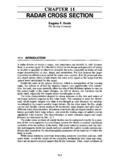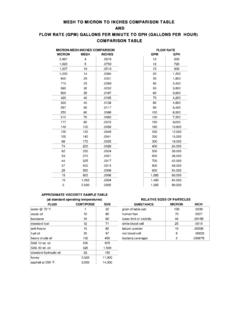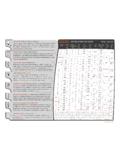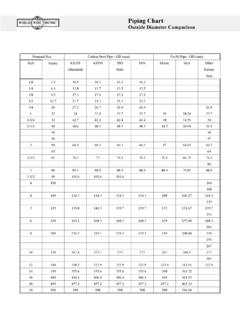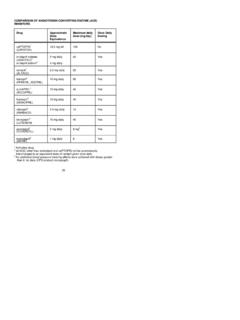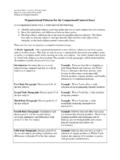Transcription of CHAPTER 18
1 CHAPTER 18 TRACKING RADARDean D. HowardLocus, Inc., a subsidiary of Kaman INTRODUCTIONA typical tracking radar has a pencil beam to receive echoes from a single targetand track the target in angle, range, and/or doppler. Its resolution cell definedby its antenna beamwidth, transmitter pulse length, and/or doppler bandwidth is usually small compared with that of a search radar and is used to exclude un-desired echoes or signals from other targets, clutter, and countermeasures. Elec-tronic beam-scanning phased array tracking radars may track multiple targets bysequentially dwelling upon and measuring each target while excluding other echoor signal of its narrow beamwidth, typically from a fraction of 1 to 1 or 2 , atracking radar usually depends upon information from a search radar or othersource of target location to acquire the target, , to place its beam on or in thevicinity of the target before initiating a track.
2 Scanning of the beam within a lim-ited angle sector may be needed to fully acquire the target within its beam andcenter the range-tracking gates on the echo pulse prior to locking on the target orclosing the tracking primary output of a tracking radar is the target location determined fromthe pointing angles of the beam and position of its range-tracking gates. The anglelocation is the data obtained from synchros or encoders on the antenna trackingaxes shafts (or data from a beam-positioning computer of an electronic-scanphased array radar). In some cases, tracking lag is measured by convertingtracking-lag-error voltages from the tracking loops to units of angle. This data isused to add to or subtract from the angle shaft position data for real-time correc-tion of tracking are a large variety of tracking-radar systems, including some thatachieve simultaneously both surveillance and tracking functions.
3 A widely usedtype of tracking radar and the one to be discussed in detail in this CHAPTER is aground-based system consisting of a pencil-beam antenna mounted on a rotatableplatform which is caused by motor drive of its azimuth and elevation position tofollow a target (Fig. ). Errors in pointing direction are determined by sensingthe angle of arrival of the echo wavefront and corrected by positioning the an-tenna to keep the target centered in the principal applications of tracking radar are weapon control and missile-FIG. AN/FPQ-6 C-band monopulse precision tracking radar installation at the NASA Wal-lops Island Station, Va. It has a 29-ft-diameter antenna and a specified angle precision of instrumentation. In both applications a high degree of precision and an ac-curate prediction of the future position of the target are generally required.
4 Theearliest use of tracking radar was in gunfire control. The azimuth angle, the ele-vation angle, and the range to the target were measured, and from the rate ofchange of these parameters the velocity vector of the target was computed and itsfuture position predicted. This information was used to point the gun in theproper direction and to set the fuzing time. The tracking radar performs a similarrole in providing guidance information and steering commands for missile-range instrumentation, the tracking-radar output is used to measurethe trajectory of the missile and to predict future position. Tracking radar whichcomputes the impact point of a missile continuously during flight is also impor-tant for range safety. Missile-range instrumentation radars are normally used witha beacon to provide a point-source target with high signal-to-noise ratio.
5 Some ofthese systems achieve a precision of the order of mil in angle and a rangeaccuracy of 5 CHAPTER describes the conical-scan, sequential-lobing, and monopulse(both phase comparison and amplitude comparison) tracking-radar techniques,with the main emphasis on the amplitude-comparison monopulse SCANNINGANDLOBINGThe first technique used for angle tracking of targets by radar was to sense thetarget location with respect to the antenna axis by rapidly switching the antennabeam from one side of the antenna axis to the other, as in Fig. The originaltracking radars of this type, such as the SCR-268, used an array of radiating el-ements which could be switched in phase to provide two beam positions for thelobing operation. The radar operator observed an oscilloscope that displayed sideby side the video returns from the two beam positions.
6 When the target was onaxis, the two pulses were of equal amplitude (Fig. ); when the target movedoff axis, the two pulses became unequal (Fig. ). The radar operator, observ-ing the existence of an error and its direction, could position the antenna to regaina balance between the two beam positions. This provided a manual tracking lobing technique was extended to continuous rotation of the beam aroundthe target (conical scan) as in Fig. Angle-error-detection circuitry is pro-vided to generate error voltage outputs proportional to the tracking error andwith a phase or polarity to indicate the direction of errors. The error signal actu-ates a servosystem to drive the antenna in the proper direction to reduce the errorto beam scanning is accomplished by mechanically moving the feedof an antenna since the antenna beam will move off axis as the feed is moved offthe focal point.
7 The feed is typically moved in a circular path around the focalpoint, causing a corresponding movement of the antenna beam in a circular patharound the target. A typical block diagram is shown in Fig. A range-tracking system is included which automatically follows the target in range, withrange gates that turn on the radar receiver only during the time when the echo isexpected from the target under track. Range gating excludes undesired targetsand noise. The system also includes an automatic gain control (AGC) necessaryto maintain constant angle sensitivity (volts of error-detector output per degree ofFIG. Angle error sensing in one coordinate by switching theantenna beam position from one side of the target to the other, (a)Target located on the antenna axis, (b) Target at one side of the an-tenna ) independent of the amplitude of the echo signal.
8 This provides the constantgain in the angle-tracking loops necessary for stable angle feed scan motion may be either a rotation or a nutation. A rotating feedturns as it moves with circular motion, causing the polarization to rotate. Anutating feed does not rotate the plane of polarization during the scan; it has amotion like moving one's hand in a circular radar video output contains the angle-tracking-error information in the en-velope of the pulses, as shown in Fig. The percentage modulation is pro-portional to the angle-tracking error, and the phase of the envelope function rel-ative to the beam-scanning position contains direction information. Angle-tracking-error detection (error demodulation) is accomplished by a pair of phasedetectors using a reference input from the scan motor.
9 The phase detectors per-form essentially as dot-product devices with sine-wave reference signals at thefrequency of scan and of proper phases to obtain elevation error from one andTARGETBEAMABEAM BBEAM ARETURNBEAMBRETURNRADAR(a)SCOPE PRESENTATIONTARGETBEAM BBEAM A(b)BEAMARETURNBEAMBRETURNRADARFIG. Conical-scan SERVO CHANNELFIG. Block diagram of a conical-scan error from the other. For example, the top scan position may be chosenas zero phase for a cosine function of the scan frequency. This provides a posi-tive voltage output proportional to the angle error when the target is above theantenna axis. The reference signal to the second phase detector is generated witha 90 phase relation to the original reference. This provides a similar error voltageproportional to the azimuth-angle error and with polarity corresponding to the di-rection of secant correction (Fig.)
10 Is necessary in any conventional elevation-over-azimuth tracking radar where the elevation drive system rotates when theTARGET AXISBEAM ROTATIONANTENNAREFLECTORTRANSMITTERSYNCH RONIZERGENERATORDISPLAYANDRANGINGDUPLEXE RROTATINGECCENTRIC FEEDSCAN AXISMAINBEAMSERVODRIVEMOTORSSCAN MOTORMIXERIFAMPLIFIERSECONDDETECTORLOCAL OSCILLATORAGCRANGEGATESERVO REFERENCE VOLTAGEELEVATION SERVO CHANNELMOTOR GENERATORSERVOAMPLIFIERERRORDEMODULATORE RRORDETECTORSERVO STABILIZATION FEEDBACKMOTOR GENERATORSERVOAMPLIFIERSECANTGAINFIG. (a) Angle error information contained in the enve-lope of the received pulses in a conical-scan radar. (6) Refer-ence signal derived from the drive of the conical-scan changes azimuth. A target flying a passing course by the radar will, at itsclosest point to the radar, cause the azimuth servo to drive faster at high eleva-tion angles than at low elevation angles.
